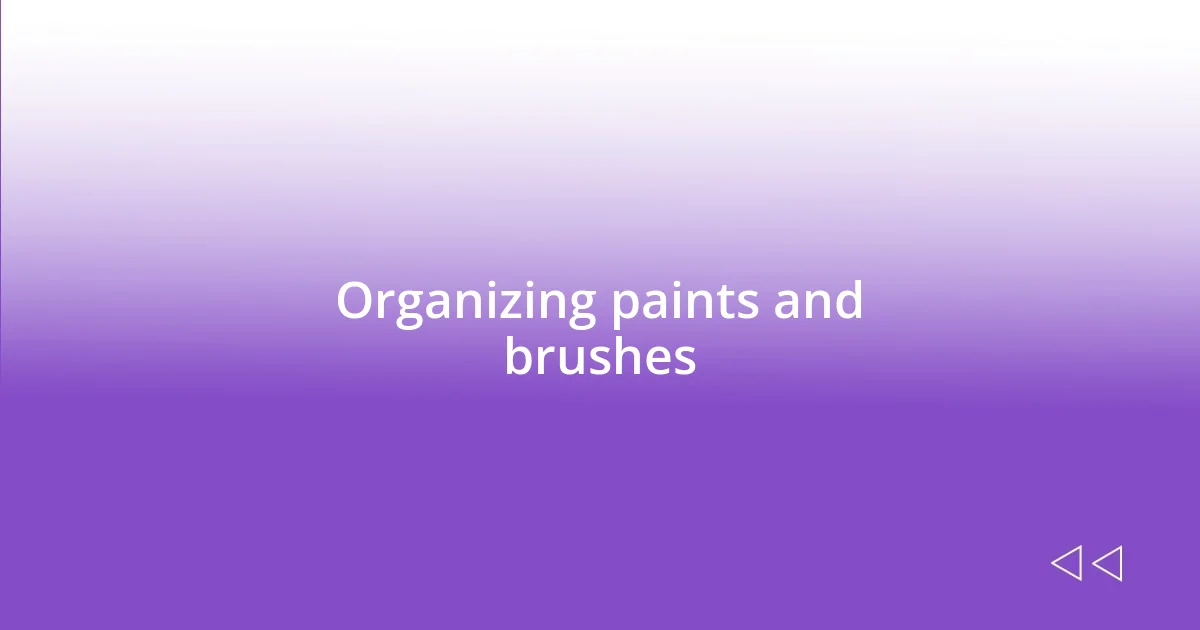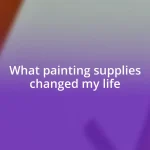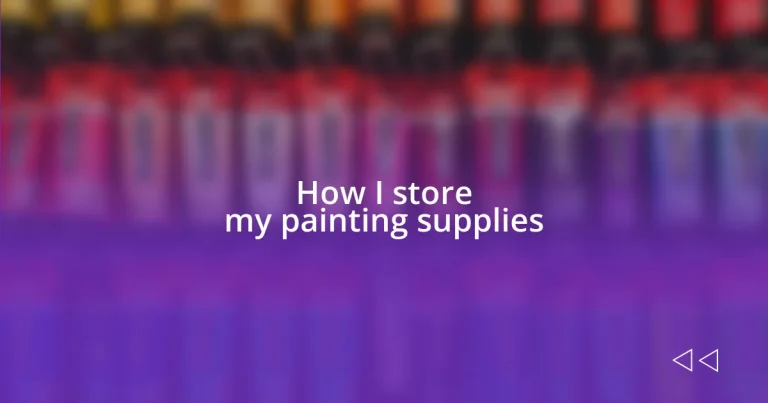Key takeaways:
- Opt for clear, stackable, and sturdy containers to enhance accessibility and organization of painting supplies.
- Implement a labeling system and categorize materials by color and type to streamline the creative process and eliminate frustration.
- Maximize space creatively with vertical storage and repurpose everyday items for effective organization in small areas.

How to choose storage containers
When it comes to choosing storage containers for my painting supplies, I always think about accessibility first. I can’t tell you how frustrating it is to dig through a jumbled mess just to find the right brush. Clear containers are my go-to because I can easily spot what I need, and I feel a sense of calm knowing everything is in its place.
I also consider the size and shape of the containers. Last year, I made the mistake of buying large bins that took up too much space in my studio. Now, I prefer smaller, stackable options that not only save space but allow me to categorize my supplies by type. Have you ever felt overwhelmed by the sheer volume of materials you own? Finding the right size can really help create a more organized environment and reduce that clutter anxiety.
Don’t forget about the material! I often choose sturdy plastic because it’s lightweight and resilient. When I invested in some high-quality containers, I was amazed at how they stood up to my clumsy moments and made cleaning a breeze. Reflecting on my experiences, I encourage you to think about what will best protect your supplies and fit your lifestyle.

Organizing paints and brushes
When organizing my paints and brushes, I like to create a system that not only makes sense but also inspires me. I use small, labeled containers for each paint color, which helps me feel a deeper connection to my materials. Just the other day, as I sorted through my brushes, I remembered how overwhelming it was when they were all mixed up; it was like searching for a needle in a haystack, but now, I’m able to pick the perfect brush almost intuitively.
Here’s a simple method I follow for my paints and brushes:
- Categorize by Color: I group paints in the order of the color wheel to make selection easier.
- Use a Brush Holder: A simple mason jar keeps my brushes upright and accessible.
- Label Everything: I label my containers with the color names to avoid confusion.
- Clean Regularly: I set aside time every month to clean my brushes and reorganize my paints, ensuring everything stays fresh and easy to use.
This approach has helped me maintain a creative flow. Each time I reach for a brush, I feel inspired rather than frustrated, making my painting sessions much more enjoyable.

Storing canvases and paper
When it comes to storing canvases and paper, I’ve learned that the way you approach organization can significantly impact your creative process. I use vertical storage to keep my canvases and large sheets of paper from getting damaged. Early on, I made the mistake of stacking them flat, which led to creases and warping. Now, a simple investment in a vertical rack makes such a difference: I can easily access what I need without worrying about damaging my surfaces.
For smaller sheets of paper, I found that flat file boxes are my best friends. They allow me to categorize different sizes and types—watercolor, sketch, and mixed media—without folding or bending them. Recently, while rummaging through a stack that used to sit in a corner, I rediscovered papers I forgot I had. It felt like discovering hidden treasures! The joy of finding unused materials not only spurred my creativity but made me realize the importance of proper storage.
Lastly, don’t underestimate the power of proper labeling! I label each box according to content type and size. I remember an instance when I was prepping for a workshop and frantically searched for my sketch paper. I finally figured out how crucial it was to have this in place. Now, with everything clearly labeled, I save time and frustration, allowing me to dive right into my creative work.
| Storage Method | Description |
|---|---|
| Vertical Racks | Easily accessible, prevents damage and warping of canvases. |
| Flat File Boxes | Allows for organization of various paper types without bending. |
| Labeling | Helps in quick identification of materials, saves time. |

Tips for maintaining supplies
Maintaining painting supplies can be a bit of a challenge, but I’ve developed some routines that really help. One significant habit I’ve adopted is to regularly check the expiration dates on my supplies, especially mediums and paints. The first time I used an old tube of paint, I was so excited, only to find it had dried out inside. It felt like a creative roadblock in that moment! Now, I simply set a reminder every few months to evaluate what needs replacing, and it keeps my materials fresh.
I also have a peculiar fondness for my cleaning routine. After a creative session, I make it a point to clean my brushes immediately. I remember one time I left my brushes for a few days, and the bristles became stiff as a board. It pained me to see them in such a state! Now, I take five minutes post-painting to rinse them in warm water and reshape the bristles, ensuring they’re always ready for my next inspiration. Nothing feels worse than having a great idea and reaching for a brush that has seen better days.
Lastly, I can’t emphasize enough the joy of using airtight containers for mediums and varnishes. I learned this the hard way when I opened a can of varnish only to find it had thickened beyond use. It was a financial setback, and honestly, a bit disheartening. Now, I store everything in secure, labeled jars. I find that taking this simple step not only keeps my materials in good shape but also gives me peace of mind, knowing that my supplies are ready and waiting for whenever creativity strikes. How often do you check on your supplies? It’s a small but meaningful practice.

Setting up a creative workspace
Creating a creative workspace is a truly personal journey that can set the tone for your entire painting experience. I experiment with different layouts, and I’ve found that having a dedicated corner just for art supplies helps me channel my creativity. It’s fascinating how a simple arrangement can inspire new ideas; the moment I painted my workspace a calming blue, I immediately felt more at ease and connected to my artistic side.
Lighting is another crucial aspect that can’t be overlooked. A well-lit area makes a world of difference—not just for visibility but also for the mood it creates. I remember when I first started painting in the evening with just one desk lamp. The struggle was real! Now, I have a combination of natural light during the day and soft, adjustable LED lights at night. It feels like I’m setting the stage for my creative performance every time I walk into that space.
Lastly, I’ve embraced the joy of personalization. Surrounding myself with inspiring objects—like my favorite art books, a little plant, and even photos of artwork that moved me—helps ignite my imagination. Think about your own space: what would make it feel uniquely yours? For me, it’s a vibrant paint splatter on my desk that acts as a constant reminder of my artistic journey. Each element in my workspace tells a story, and I’ve learned that the more I invest in this environment, the more my creativity flourishes.

Maximizing small storage areas
When I first started painting, I struggled to find enough space for all my supplies. I quickly realized that vertical storage was my best friend. Installing simple shelves allowed me to utilize wall space efficiently, creating an organized system for my brushes, paints, and canvases. It felt like I had discovered a hidden room for creativity right in my small apartment!
I also found that using small containers or caddies on my desk makes a remarkable difference. These containers keep similar items together, making it easy to grab what I need without digging through piles. It’s reassuring to see everything in its place—I can’t help but smile every time I catch a glimpse of that organized chaos. Have you ever noticed how a tidy space can inspire a fresh burst of creativity?
Furthermore, I highly encourage anyone dealing with limited space to think outside the box—literally! I used an over-the-door shoe organizer to store my tubes of paint and other small supplies. This unexpected solution made me realize that maximizing storage often takes a little creativity. It became a fun conversation starter among friends, as they marveled at how I turned a simple storage solution into a functional piece of art. How can you repurpose everyday items to enhance your own storage situation?














